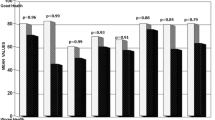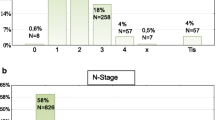Abstract
This study examines differences and similarities in the quality of life of 253 cancer patients with good, medium and poor prognoses. Our main hypothesis was that patients with a good prognosis will experience a higher quality of life than patients with a medium or poor prognosis. A multivariate analysis of covariance of eight quality of life scales was performed with prognosis as a factor and with age, sex, and the duration of the illness as covariates. Significant main effects of prognosis were found for the general QOL-scale and for physical aspects of quality of life. There were, however, only marginal and non-significant effects of prognosis groups on social and psychological functioning. A final multivariate analysis confirms earlier findings that performance status shows a weak but significant relationship with the psychological functioning. Thus, the physical condition of the patient at the time of measurement seems to have some influence on the psychological functioning, whereas the severity of the disease as inducated by the classification into prognosis groups does not. These results question the general attitude that seriously ill cancer patients have reduced social and psychological well-being. An alternative interpretation is that the scales used to measure psychological aspects of quality of life are inadequately sensitive.
Similar content being viewed by others
References
Martin LR. Overview of the psychosocial aspects of cancer. In: Cohen J, Cullen JW, Martin LR, eds. Psychosocial Aspects of Cancer. New York: Raven Press, 1982: 1–8.
Moorey S. The psychological impact of cancer. In: Tiffany R, Webb P, eds. Oncology for Nurses and Health Care Professionals. London: Harper & Row, 1988: 14–48.
DeHaes JCJM, VanKnippenberg FCE. The quality of life of cancer patients: a review of the literature. Soc Sci Med 1985; 20: 809–17.
Clark A, Fallowfield LJ. Quality of life measurements in patients with malignant disease: a review. J R Soc Med 1986; 79: 165–69.
Baum E, Ebbs SR, Fallowfield LJ, Fraser CA. Measurement of quality of life in advanced breast cancer. Acta Oncol 1990; 29: 391–5.
Hörnquist JO, Hansson B, Åkerlind L, Larsson J. Severety of disease and quality of life: A comparison in patients with cancer and benign disease. Quality Life Res 1992; 1: 35–41.
Till JE. Quality of life measurements in cancer research. In: DeVita VT, Hellman S, Rosenberg SA, eds. Important Advances in Oncology 1992. Philadelphia: Lippincott Company, 1992: 189–204.
Cassileth BR, Lusk EJ, Tenaglia AN. A psychological comparison of patients with malignant melanoma and other dermatologic disorder. J Am Acad Dermatol 1982; 7: 742–6.
Cassileth BR, Lusk EJ, Strouse TB, et al. Psychosocial status in chronic illness: A comparative analysis of six diagnosis groups. N Engl J Med 1984; 311: 506–11.
Craig TJ, Comstock GW, Geiser PB. The quality of survival in breast cancer: a case-control comparison. Cancer 1974; 33: 1451–7.
Schmale AH, Morrow GR, Schmitt MH, et al. Well-being of cancer survivors. Psychosom Med 1983; 45: 163–9.
Ganz PA, Schag AC, Lee J, Polinsky ML, Tan S-J. Breast conservation versus mastectomy. Is there a difference in psychological adjustment or quality of life in the year after surgery? Cancer 1992; 69: 1729–38.
Irwin PH, Gottlieb A, Kramer S, Danoff B. Quality of life after radiation therapy: a study of 309 cancer survivors. Soc Ind Res 1982; 10: 187–210.
Drettner B, Ahlbom A. Quality of life and state of health for patients with cancer in the head and neck. Acta Otolaryngol 1983; 96: 307–14.
Linssen ACG, Hanewald GJFP, Huisman S, Van Dam FSA. The development of a well-being (quality of life) questionnaire at the Netherlands Cancer Institute. In: Linssen ACG, Hanewald GJFP, Huisman S, Van Dam FSA, eds. Proceeding of the Third EORTC Workshop on Quality of Life. Paris: 1982: 82–110.
Stensman R. Severely mobility-disabled people assess the quality of their lives. Scand J Rehab Med 1985; 17: 87–99.
Morris JN, Suissa S, Sherwood S, Wright SM, Greer D. Last days: a study of the quality of life of terminally ill cancer patients. J Chronic Dis 1986; 39: 47–62.
Kaasa S, Mastekaasa A, Naess S. Quality of life of lung cancer patients in a randomized clinical trial evaluated by a psychosocial well-being questionnaire. Acta Oncol 1988; 27: 335–42.
Bergman B, Sullivan M, Sörensen S. Quality of life during chemotherapy for small cell lung cancer. Acta Oncol 1992; 31: 19–28.
Cassileth BR, Lusk EJ, Guerry D, et al. Survival and quality of life among patients receiving unproven as compared with conventional cancer therapy. N Engl J Med 1991; 324: 180–5.
Aaronson NK, Ahmedzai S, Bullinger M, et al. The EORTC core quality-of-life questionnaire: Interitem results of an international field study. In: Osoba D, ed. Effect of Cancer on Quality of Life. Boca Raton, Boston, Ann Arbor, London: CRC Press, 1991: 185–204.
Aaronson NK, Ahmedzai S, Bergman B, et al. The European organization for research and treatment of cancer QLQ-C30: A quality-of-life instrument for use in international clinical trials in oncology. J Natl Cancer Inst 1993; 85: 365–76.
Cella DF, Tulsky DS, Gray G, et al. The functional assessment of cancer therapy scale: development and validation of the general measure. J Clin Oncol 1993; 11: 570–9.
Cella DF, Orofiamma B, Holland JC, et al. The relationship of psychological distress, extent of disease, and performance status in patients with lung cancer. Cancer 1987; 60: 1661–7.
Bukberg J, Penman D, Holland JC. Depression in hospitalized cancer patients. Psychom Med 1984; 46: 199–212.
Cassileth BR, Lusk EJ, Miller DS, Brown LL, Miller C. Psychological correlates of survival in advanced malignant disease. N Engl J Med 1985; 312: 1551–5.
Cassileth BR, Walsh WP, Lusk EJ. Psychosocial correlates of cancer survival: a subsequent report 3 to 8 years after cancer diagnosis. J Clin Oncol 1988; 6: 1753–9.
Zubrod CG, Schneiderman M, Frei E, et al. Appraisal of methods for the study of chemotherapy of cancer in man: comparative therapeutic trial of nitrogen mustard and triethylene. J Chronic Dis 1960; 11: 7–33.
Karnofsky DA, Abelman WH, Craver LF, Burchenal JH. The use of the nitrogen mustards in the palliative treatment of carcinoma. With particular reference to bronchogenic carcinoma. Cancer 1948; 1: 634–656.
Osoba D. Measuring the effect of cancer on quality of life. In: Osoba D, ed. Effect of Cancer on Quality of Life. Boca Raton, Florida: CRC Press, Inc., 1991: 25–40.
Lindley C. Quality of life measurements in oncology. Pharmacotherapy 1992; 12: 346–52.
Kaasa S. Measurement of quality of life in clinical trials. Oncology 1992; 49: 288–94.
Cella DF, Tulsky DS. Definition and methodology. Measuring quality of life today: methological aspects. Oncology 1990; 4: 29–38.
Donovan K, Sanson-Fisher RW, Redman S. Measuring quality of life in cancer patients. J Clin Oncol 1989; 7: 959–68.
Tchekmedyian NS, Cella DF. Quality of life in current oncology practice and research. Appendix 1. Oncology 1990; 4: 215.
Aaronson NK, Bullinger M, Ahmedzai S. A modular approach to quality of life assessment in cancer clinical trials. Recent Res Cancer Res 1988; 3: 231–49.
Bjordal K, Kaasa S. Psychometric validation of the EORTC core quality of life questionnaire, 30-item version, and a diagnosis-specific module for head and neck cancer patients. Acta Oncol 1992; 31: 311–21.
Sigurdadótir V, Bolund C, Brandberg Y, Sullivan M. The impact of generalized malignant melanoma on quality of life evaluated by the EORTC questionnaire technique. Quality Life Res 1993; 2: 193–203.
Ringdal GI, Ringdal K. Testing the EORTC quality of life questionnaire on cancer patients with heterogeneous diagnoses. Quality Life Res 1993; 2: 129–40.
Mokken RJ. A Theory and Procedure of Scale Analysis. The Hague: Mounton, 1971.
Nunnally JC. Psychometric Theory. 2nd edn. New York McGraw-Hill, 1978.
Zigmond AS, Snaith RP. The hospital anxiety and depression scale. Acta Psychiat Scand 1983; 67: 361–70.
Bray JH, Maxwell SE. Multivariate Analysis of Variance. Sage University Paper Series on Quantitative Applications in the Social Sciences 07-054. London: Sage, 1985.
Toothaker LE. Multiple Comparison Procedures. Sage University Paper Series on Quantitative Applications in the Social Sciences 07-089. London: Sage, 1993.
Grogono AW, Woodgate DJ. Index for measuring health. Lancet 1971; 2: 1024–6.
Tempelaar R, DeHaes JCJM, DeRuiter JH, Bakker D, Van denHeuvel WJA, VanNieuwenhuijzen MG. The social experiences of cancer patients under treatment: a comparative study. Soc Sci Med 1989; 29: 635–42.
Garner WR, Creeland CD. Problems and methods of psychological scaling. In: Helson H, Bevan T, eds. Contemporary Approaches to Psychology. Princeton, New Jersey: Van Nostrand Company, Inc., 1967: 1–33.
DeHaes JCJM, VanKnippenberg FCE. Variance and dissent (continued). Quality of life instruments for cancer patients: ‘Babel's tower revisited’. J. Clin Epidemiol 1989; 42: 1239–41.
Helson H. Adaptation-level as a basis for a quantitative theory of frames of reference. Psychol Rev 1948; 55 297–313.
Author information
Authors and Affiliations
Additional information
This study is supported by grants no 89090/001-002 from the Norwegian Cancer Society and by the Faculty of Medicine, University of Trondheim. The study has been evaluated and approved by the Regional Ethical Committee for Medical Research.
Rights and permissions
About this article
Cite this article
Ringdal, G.I., Ringdal, K., Kvinnsland, S. et al. Quality of life of cancer patients with different prognoses. Qual Life Res 3, 143–154 (1994). https://doi.org/10.1007/BF00435257
Received:
Accepted:
Issue Date:
DOI: https://doi.org/10.1007/BF00435257




